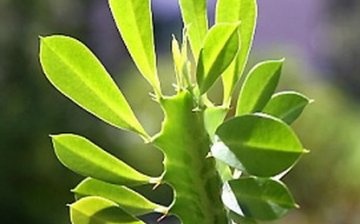Euphorbia triangular - we care and breed
This plant is ideal for busy people who often make various trips, or for decorating offices. Triangular spurge has an exquisite tropical appearance, pleasantly pleasing to the eye. Something similar to cacti, but has leaves.
Features of the soil for the growth of milkweed:
- The first and foremost condition is the presence of good drainage, otherwise the plant will die.
- To simplify your task, you can use purchased soil intended for cacti (only with a neutral reaction).
- For those who like to create their own soil, the following combination of components is suitable: mix equal parts of sod, leaf and peat soil, add sand equal to one part of the earth, and one part of brick chips - the soil is ready for favorable growth of triangular milkweed.
How to take care of it properly?
Since the root system of this perennial plant is rather weak and is located mainly close to the soil surface, it is recommended to pour stones on the bottom for the stability of the pot. Accustomed during evolution and development to grow in sunny conditions, the plant needs rays of light all year round. Feels comfortable in summer and winter at temperatures of about 25 and 16 degrees, respectively. Dry air has no effect on triangular euphorbia. Watering is done once a week (in spring and summer) and even less often in autumn and winter. Spraying can be done at will. Fertilizing / feeding the soil is best during periods of active growth of milkweed, i.e. in the spring, potassium-containing fertilizers for indoor plants.
Propagating correctly
There is nothing supernatural in breeding triangular milkweed at home. According to the laws of nature, the most favorable period for breeding behavior will be spring. The appearing processes of the flower must be cut off with a sharp knife, dried for 2-3 days, treated with activated carbon and rooted in the ground or a plastic bottle of water. It is most reasonable to transplant euphorbia once every three to four years, when it becomes cramped in the pot. This should also be done in the spring. To maintain soil fertility and saturation of the flower with minerals and trace elements, the top layer of the earth can be renewed once a year. Due to the presence of poisonous sap that flows through the "veins" of the plant, the euphorbia is not attacked by pests.



